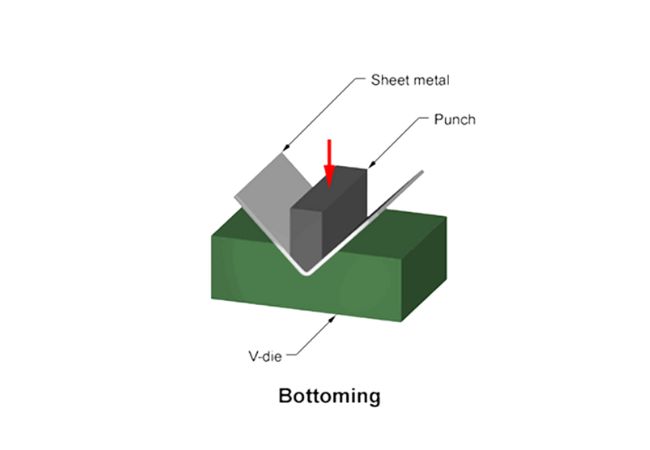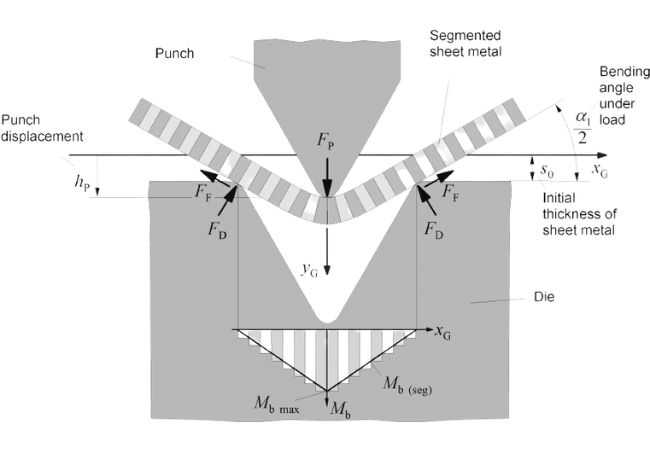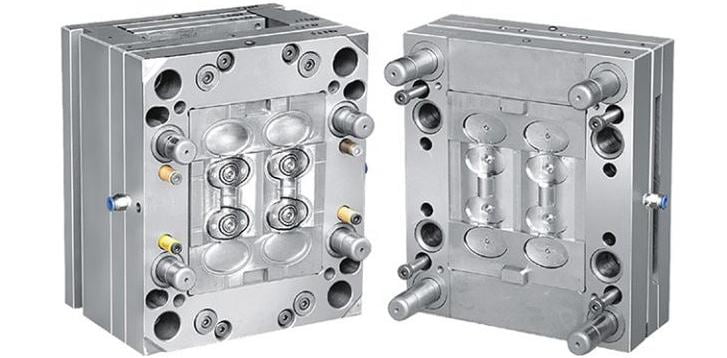The Ultimate Guide On Sheet Metal Bending
Upload Time:
Feb 24, 2024
Bending is an important process in sheet metal fabrication process. In this guide, I will explain everything you should know about sheet metal bending process. If you want to be an expert in metal bending parts, read this guide to the end.
What Is Metal Bending?
Bending sheet metal involves the deformation of a metal part plastically over an axis resulting in a geometrical change. The change is only in shape while the metal part volume remains the same.
 Sheet Metal Bending
Sheet Metal Bending
Common Types Of Sheet Metal Bending Techniques
Some of the most common bending methods are:
Folding
A bar folder or cornice brake allows you to perform folding operations on sheet metal parts. A clamping beam is pivotal in bending the part into a desired shape upon clamping. The end result is a bend in V-shape with either negative or positive angles of bend.

V-Bending
V-Bending employs a die in V-shape and punch which allows you to conduct different angled bending. By positioning the sheet metal part above the V-die, you bend the part by using a bending punch press.
The punch’s pressure point determines the sheet metal’s formed angle. You have three approaches to V-bending:

Bottoming
In this technique, you compress the sheet metal part to the bottom of the die to create a specific shape and angle. The resulting bend represents the configuration of the die tooling.
Bottoming overcomes the spring back problem by punch and die force and angle parameters shape the metal part permanently.

Coining
The accuracy and distinctive capacity to produce exemplarily metal parts makes coining a popular metal bending technique. The sheet metal bent parts don’t spring back during the procedure. This is due to the coin only slightly denting the sheet metal part, allowing you to identify the difference.
 Coining in Sheet Metal
Coining in Sheet Metal
Air Bending
Compared to bottoming and coining, air bending is a less accurate technique that is also susceptible to spring back. Nonetheless, it is easy to use since you do not employ tools.
In this process, a punch applies pressure to the sheet metal part in the die cavity. During the bending process, the metal part doesn’t touch the die bottom necessitating use of a press brake.
 Structural Model for Air Bending in Sheet Metal
Structural Model for Air Bending in Sheet Metal
Wipe Bending
In wipe bending, you secure the metal part with a clamp on which you apply force against the die. You perform the bending action by subjecting the sheet metal part to a force that impresses against the die.
 Wipe Bending Process of Sheet Metal
Wipe Bending Process of Sheet Metal
This technique has mechanical advantage, enabling you to bend objects with less power. Making obtuse bend angles, however is difficult requiring sophisticated machinery with necessary horizontal force.
Roll Bending
In roll bending, you come up with curved parts such as cones and tubes. Roller sets are central in the use of this method capable of achieving different cross-section profiles with numerous curves.
 Roll Bending for Sheet Metal
Roll Bending for Sheet Metal
Rotary Draw Bending
Here, you fasten the metal parts to a spinning die, pulling around it such that it matches the required bend radius. This technique frequently uses a supporting mandrel internally to stop the bent sheet metal part from creasing.
Rotary draw bending doesn’t graze the part’s surface unlike wipe and v-bending techniques.
 Rotary Draw Bending
Rotary Draw Bending
Additionally, you can fashion metal parts with wide bend angles and sharp edges.
Step Bending
This technique, employs multiple and successive V-bends to fashion a large radius part. The bend count and the distance in between ultimately determines the quality increasing with number. It is a cost effective method for small production volumes.
 Step Bending for Sheet Metal
Step Bending for Sheet Metal
In a nutshell, you will choose sheet metal bending machine and tools depending on the bending process.
Benefits of Sheet Metal Bending
There are many reasons why you should consider bending as a critical technique in sheet metal fabrication process.
- Increased Accuracy: Given the precise determination of k-factor and bend allowance, the metal bending process is significantly accurate.
- Increased Productivity: The bending process requires less tooling and can support automation. You can therefore undertake fast bending operation allowing high volume output.
- Less Secondary Procedures: Bending process does not require secondary processes for completion such as cutting which may require welding.
- Low Tooling Cost: The bending process employs simple tooling to undertake the process resulting in overall low cost.
- Reduce Parts Usage: Bending allows you to furnish a single piece into a desired shape without having to employ many pieces in an assembly.
- Reduced Part Weight: You can obtain desired part stiffness and strength when employing bending without recording an increase in part weight.
Sheet Metal Bending Applications
Let’s highlight some of the most common applications:
- Appliances: Many household appliances such as washing machines and blenders employ metal such as stainless steel in their construction. For instance, the formation of the drum in a washing machine is by bending sheet metal into desired shape.
- Automobile and Aircraft Industry: Parts of vehicles and aircrafts such as side panels and fuselage respectively employ bending process during formation. Bending can allow the execution of design features such as streamlining for increased efficiency.
- Construction: The construction industry employs bent sheet metals in areas such as roofing, borehole and well drilling and safety rails. Corrugated iron sheets useful in roofing houses undergo bending process as a design feature.
- Health Industry: Equipment and machinery in the health sector such as MRI machines and even beds employ metal fabrication including bending.
- Manufacturing Industry: You find application of metal bending in the manufacturing sector such as construction of boilers. To form an equipment with few stress points, bending process is undertaken instead of say, welding.
Limitations Of Bending Process
Whenever you are adopting this metal fabrication technique, it is important to pay attention to:
- High Initial Costs: Setting up equipment metal parts bending process is capital intensive compared to other materials such as plastic.
- Design Restrictions: Some metals’ physical and mechanical properties make them unsuitable for producing complicated geometries or shapes.
- Ancillary Operations: After metal bending process, you will require other secondary operations such as painting, and finishing.
Best Sheet Metal Material for Bending Process
You can bend sheet metals of different gauges or thickness. Besides, bending process is suitable for virtually all sheet metals.
Let’s look at a few:
i. Aluminium: Aluminium combines easily with other elements to form alloys with a wide variety of properties. Some of the most common alloys are:
- Aluminum 5052: This alloy type has impressive malleability with no cracking deficiencies except when reworking.
- Aluminium 6061: This aluminium alloy presents a challenge when bending as is prone to cracking. The metal weakens on cold bending while malleability increases by annealing.
ii. Annealed Alloy Steel: Depends on the alloy with the 4140 alloy offering impressive malleability less chance of cracking.
iii. Brass: The zinc concentration in brass is crucial since the more zinc the less bendable is the material. Useful when undertaking simple bending procedures with more complex processes requiring heating.
iv. Bronze: Bending bronze is not a simple task in addition to its tendency to crack unless you treat it by heating it.
v. Copper: Has high malleability making it easily bendable.
vi. Steel: With this material, you find different variants with hot rolled steel being more malleable than cold rolled steel. The main variants are:
- Low Carbon Steel: Available in hot and cold rolled forms, mild steel has a high degree of ductility. However, you need to coat it to prevent corrosion in the presence of moisture such as through galvanization.
- Spring Steel: Is malleable upon annealing and heat is necessary to re-bend when work hardened.
- Stainless Steel: Is an alloy of mild steel containing in excess of 10.5% chromium making it highly resistant to corrosion.
vii. Titanium: The rigidity of titanium is such that you need to fashion an extended internal radius of bend. Since springback is a problem, you need to over-bend sheet metal parts of this material.
Sheet Metal Bending Tools And Equipment
Depending on the type of bending style you wish to achieve, you can consider any of these tools and equipment:
i. The brake: Is the main tool for bending metal with different varieties as follows:
- Cornice Brake: Clamps a sheet metal part to a surface that’s flat using force to crease or bend it straight.
- Press Brake: Employs a punch and die combination to make bends in different shapes (U, V, etc.)
- Box-and-Pan Brake: Produces several bend lines using finger like metal projections.
- Straight Brake: Have a robust design that is simple to use with unmatched bending accuracy.
- Bending Brake: Can bend different materials neatly and with different thicknesses.
ii. Bar Folder: A compact, straightforward bending device with one handle that employs single-motion bending.
iii. Plate Roller: Performing bending operations to form rounded components such as rigs, boiler equipment, heat exchangers and tunnel supports.
iv. Bending folder: Bends sheet metal parts with a maximum thickness of one millimeters.
v. Sheet Metal Roller: Produce a broad variety of circular objects, cylinders, arcs and bends.
Design Tips For Sheet Metal Bending Parts
Let’s look at some common design rules that will help you get the best designs and shapes:
i. Bend Relief: Create bend reliefs by laser cutting small incisions on the flange design’s sides with a width exceeding the material thickness.
ii. Bending Direction: The bending direction should not correspond to that of rolling the material.
iii. Bending Line is Parallel to a Side: Such a scenario produces unreliable results. A parallel side is necessary for placement purposes.
iv. Chamfered Sides: The chamfer should terminate before the detail’s base. You achieve good bends by adequately spacing chamfers.
v. Closely Spaced Bends: When incorporating consecutive bends, make the middle part of the design longer than the flanges.
vi. Hole Distance from Bend: The holes may distort if in close proximity to the bend.
vii. Maintain Bends on Same Line: Especially where there is a series of flanges.
viii. Minimum Flange Length: You chose the die width based on thickness. Constructing a flange with minimal height results in termination at the fissure.
ix. Rivet Nuts: Insert rivet nuts prior to bending close to the bending line to ensure they are secure.
x. Symmetry: Try to make your pieces as symmetrical as possible to avoid deficient bending process.
Conclusion
As you can see sheet metal bending is an important process sheet metal fabrication. I hope with the information in this guide, you can bend all sheet metals to a suitable shape and design.
Relevant News









